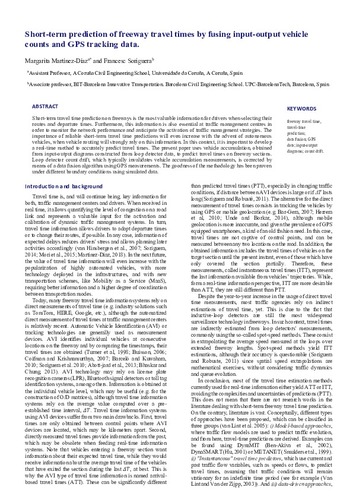Mostra el registre d'ítem simple
Short-term prediction of freeway travel times by fusing input-output vehicle counts and GPS tracking data
| dc.contributor.author | Martínez Díaz, Margarita |
| dc.contributor.author | Soriguera Martí, Francesc |
| dc.contributor.other | Universitat Politècnica de Catalunya. Departament d'Enginyeria Civil i Ambiental |
| dc.date.accessioned | 2021-02-22T14:05:46Z |
| dc.date.available | 2021-12-31T01:32:20Z |
| dc.date.issued | 2021-03 |
| dc.identifier.citation | Martinez, M.; Soriguera, F. Short-term prediction of freeway travel times by fusing input-output vehicle counts and GPS tracking data. "Transportation letters: the international journal of transportation research", Març 2021, vol. 13, núm. 3, p. 193-200. |
| dc.identifier.issn | 1942-7867 |
| dc.identifier.uri | http://hdl.handle.net/2117/340292 |
| dc.description | This is an Accepted Manuscript of an article published by Taylor & Francis Group in Transportation Letters on December 2020, available online at: http://www.tandfonline.com/10.1080/19427867.2020.1864134 |
| dc.description.abstract | Short-term travel time prediction on freeways is the most valuable information for drivers when selecting their routes and departure times. Furthermore, this information is also essential at traffic management centers in order to monitor the network performance and anticipate the activation of traffic management strategies. The importance of reliable short-term travel time predictions will even increase with the advent of autonomous vehicles, when vehicle routing will strongly rely on this information. In this context, it is important to develop a real-time method to accurately predict travel times. The present paper uses vehicle accumulation, obtained from input-output diagrams constructed from loop detector data, to predict travel times on freeway sections. Loop detector count drift, which typically invalidates vehicle accumulation measurements, is corrected by means of a data fusion algorithm using GPS measurements. The goodness of the methodology has been proven under different boundary conditions using simulated data. |
| dc.description.sponsorship | This research has been partially funded by the Spanish Ministry of Science and Innovation (Ministerio de Ciencia e Innovación, Gobierno de España), within the Program for Research Aimed at the Society’s Challenges (grant ref. PID2019-105331RB-I00). Authors especially acknowledge the work of Enrique Jiménez, who provided us with the simulation data to perform the case study. |
| dc.format.extent | 8 p. |
| dc.language.iso | eng |
| dc.publisher | Informa UK (Taylor & Francis) |
| dc.subject | Àrees temàtiques de la UPC::Enginyeria civil::Infraestructures i modelització dels transports::Transport per carretera |
| dc.subject.lcsh | Travel time (Traffic engineering) |
| dc.subject.other | Freeway travel time |
| dc.subject.other | travel- time prediction |
| dc.subject.other | data fusion |
| dc.subject.other | GPS data |
| dc.subject.other | input-output diagrams |
| dc.subject.other | count drift. |
| dc.title | Short-term prediction of freeway travel times by fusing input-output vehicle counts and GPS tracking data |
| dc.type | Article |
| dc.subject.lemac | Temps de recorregut |
| dc.contributor.group | Universitat Politècnica de Catalunya. BIT - Barcelona Innovative Transportation |
| dc.identifier.doi | 10.1080/19427867.2020.1864134 |
| dc.description.peerreviewed | Peer Reviewed |
| dc.relation.publisherversion | https://www.tandfonline.com/doi/abs/10.1080/19427867.2020.1864134 |
| dc.rights.access | Open Access |
| local.identifier.drac | 30612907 |
| dc.description.version | Postprint (author's final draft) |
| local.citation.author | Martinez, M.; Soriguera, F. |
| local.citation.publicationName | Transportation letters: the international journal of transportation research |
| local.citation.volume | 13 |
| local.citation.number | 3 |
| local.citation.startingPage | 1 |
| local.citation.startingPage | 193 |
| local.citation.endingPage | 8 |
| local.citation.endingPage | 200 |
Fitxers d'aquest items
Aquest ítem apareix a les col·leccions següents
-
Articles de revista [3.017]
-
Articles de revista [136]


